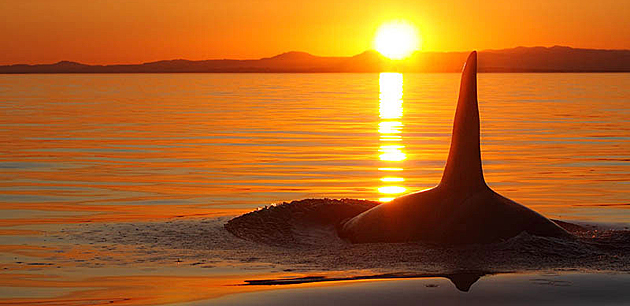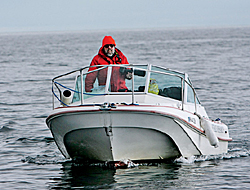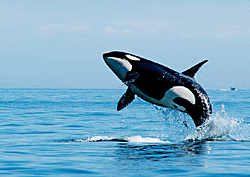sierraclub.org - sierra magazine - november/december 2009 - empty sound


Empty Sound
Three pods of orcas known as the "Southern Residents" have feasted on salmon in Puget Sound for thousands of years. Now they're vanishing.
By Thayer Walker

One of the Southern Residents cruises Haro Straight off San Juan Island.
Ken Balcomb's living room feels like a natural history museum. Two life-size fiberglass porpoises, cast from the frozen remains of animals that Balcomb found dead in the field, hang by ropes beside the fireplace. Mounted above a doorway is the baleen plate from a bowhead whale, its plankton-filtering hairs brushing the wall. On the coffee table, crowding a pile of books, rests the giant, toothy skull of a 26-foot killer whale, nearly as big as the table itself. There's a small television by the piano, but for years the most exciting shows around here have unfolded on the other side of Balcomb's bay windows, in the frigid waters of Washington's Salish Sea.
"When the salmon are running, the killer whales come right up against the shore," Balcomb says, pointing to an exposed chunk of reef a few feet offshore. The 69-year-old scratches his white beard and continues in a quiet, patient drawl. "That's why I picked this house."
 Orca expert Ken Balcomb in his natural habitat.
Orca expert Ken Balcomb in his natural habitat. Balcomb's home, which sits on a two-acre rise on San Juan Island, doubles as the Center for Whale Research. Through more than three decades of study, this grizzled former navy lieutenant has become a leading expert on the three pods of Puget Sound whales known as the "Southern Residents." His research, papers, photographs, and books have helped lay the foundation for much of what science knows about these creatures.
On this unseasonably hot and clear May morning, however, no black fins cut the water beyond his window. This is whale season, but he hasn't seen the Southern Residents for days and doesn't expect them back anytime soon. They've been spending less and less time around San Juan, and last year an alarming seven whales--nearly 10 percent of the population--failed to return. Standing in his living room, scanning the water for the missing giants, Balcomb faces the most alarming question of his career: What's killing the killer whales?
Found in every ocean, killer whales are the planet's most widely distributed cetaceans. The northeastern Pacific orcas in Puget Sound are thought to be a subspecies. Balcomb began studying the whales in 1976 after getting a zoology degree at the University of California and spending seven years as a navy sonar specialist. When his original government-funded census project expired after seven months, he continued his research, supporting himself by hawking orca T-shirts and buttons. During tough times he ate roadkill rabbit for dinner. "This is a high-rent area now, but we were scratching by in the '80s," he recalls. "I told myself I'd do whatever it takes to be here."
 Southern Resident K35, a seven-year-old male, breaching. Distinctive markings make each whale identifiable.
Southern Resident K35, a seven-year-old male, breaching. Distinctive markings make each whale identifiable. Today, Balcomb knows exactly how many orcas call these waters home (85) and can identify them individually. He's built a family tree for each pod and documented the animals' personal histories and complex social behavior. "Ken has a sixth sense when it comes to these animals," says biologist Brad Hanson with the Northwest Fisheries Science Center, part of the National Oceanic and Atmospheric Administration (NOAA). Balcomb's work shows the sound's orcas are disappearing. The Southern Residents have lived there for thousands of years. Even in a pristine state, the area probably only supported a few hundred orcas. By the 1960s, the population had dropped to around 120. Then came the captures.
During the '60s and '70s, aquariums and amusement parks removed 36 Southern Residents, killing at least 11 others in the process. The captures had contradictory effects. Widespread public exposure to performing whales helped change orcas' image from ferocious killers to the intelligent, curious creatures later celebrated in Free Willy. But the tightly knit Puget Sound pods, considered by the NOAA Fisheries Service to be a "distinct population segment," were decimated. Orcas can live for more than 90 years and gestate for 17 months, and the captures skewed the age and sex composition of the small, slow-reproducing population, putting it at greater risk of inbreeding and extinction. Numbers fell so severely that in 2005 the Southern Residents were listed as endangered.
The skull sitting on Balcomb's coffee table illustrates one of the reasons why. "See how thick the jaws are and the size of the teeth?" he says, pointing to dentition that looks like miniature artillery shells. "This was a seal-eater from Japan. The Residents aren't built like that. They're built for fish."
That's become a problem. Much of the Southern Residents' diet consists of chinook, the world's largest salmon, which can top 100 pounds. But nine chinook runs in the western United States are either endangered or threatened. In predevelopment times, up to 30 million salmon crowded the Columbia River basin each year. Between 1938 (when the Bonneville Dam began producing electricity) and 2000, annual runs peaked at 3.2 million. But estimates for 2008 total only 1.5 million fish.
Bob Otis, an animal behavior expert at Wisconsin's Ripon College, has studied the Southern Residents for 20 years and ascribes recent behavioral changes to a lack of food. Since 2002, he says, individuals in a group called J pod have been spending their time around San Juan farther apart from each other. "That's a huge behavioral difference," says Otis. "The most reasonable hypothesis is that they are searching for food."
The seven whales that disappeared between November 2007 and October 2008--more than twice the average annual mortality rate--may have simply starved. Because orcas are highly social and generally remain in their pods for life, whales that go missing for a year are considered dead. Before disappearing, one breeding female was seen with "peanut head," a condition brought on by malnutrition in which loss of fat gives the whale's head a peanut-shell shape.
"We'll have reproductive animals for another 20 years," says Balcomb, "but if we don't have a stable food supply, we won't have these [Southern Resident] whales by the next century. And there's a low probability that they'll make it that far."
Biologist Hanson isn't convinced the die-off has been caused by a dearth of salmon alone. Disease, he says, is an understudied threat (although one that can be exacerbated by a lack of food). Biopsy samples have revealed that killer whales carry a medley of toxic industrial chemicals in their blubber, including the flame retardant polybrominated diphenyl ether (PBDE), found in everything from building materials to T-shirts.
Over the past several decades, PBDE contamination levels have doubled every four to six years. In Puget Sound, the chemical enters via polluted runoff and then bioaccumulates up the food chain. PBDE has been linked to immune and reproduction problems in pinnipeds; the Southern Residents have so much of the chemical in their blubber they've jokingly been called "fireproof." When killer whales don't get enough food, they metabolize their blubber and its poisons.
"This is a juggernaut of a problem," says Lynne Barre, a marine mammals specialist with NOAA Fisheries and author of the Southern Resident recovery plan. "It's not just about killer whales; it's about the health of the ocean and our entire ecosystem." If the environment can't support killer whales, asks Barre, how well can it support humans? Solving the problem demands fundamental changes in forestry practices, dam management, the use of toxic substances, and wastewater management (see "Cleaning Up Puget Sound," below). "Everyone needs to make hard decisions about what we buy, how we fertilize the lawn, and how we manage fisheries," warns Barre. Otherwise, goodbye salmon, goodbye orcas.
Walk around Friday Harbor, San Juan Island's cozy county seat, and you'll get no indication that the Southern Residents are in trouble. Killer whales are on T-shirts in shop windows and in paintings in art galleries; they're plastered on taxicabs and even have their own museum. There are 17 whale-watching and kayak-touring businesses on the island (population 6,491); countywide, tourism is a $127 million industry.
"This is an orca-based economy," says Jason Gunter, manager of Discovery Sea Kayak. He estimates that 75 percent of his clients sign up to see killer whales. "People aren't coming here to see harbor seals. If there were no more orcas, this economy would collapse."
After four days on the island I have yet to see one. My best bet, suggests Balcomb, is to hop on a whale-watching boat. Word has spread of a transient pod 12 miles south. So I join a dozen or so tourists on the Western Explorer, a jet boat commanded by Captain Ivan Reiff.
As we pull out of the harbor, Reiff does his best to manage our expectations: "There's more than just killer whales around here," he says. "You'll see harbor seals, bald eagles, and sometimes even minke whales."
In 30 minutes we're at the mouth of the Strait of Juan de Fuca, the snowcapped Cascade Range arcing around us. Suddenly, a six-foot dorsal fin breaks the surface. Seconds later, a half-dozen smaller fins follow. We've found whales.
The pod is shadowed by 10 other boats and a flock of screeching gulls. During peak season it's not unusual for 30 to 40 boats to follow a pod, leading to concerns that the traffic disrupts the orcas' ability to communicate, and thereby alters their behavior. State regulations demand that boats stay at least 300 feet away.
Unlike the Residents, transients feed on marine mammals, and apparently they have found a meal. One of the bigger orcas lunges through the water--perhaps toward an unlucky pinniped below--while as many as 20 others (an unusually large group for transients) loll around. Over the next 90 minutes they put on a show, breaching, "spyhopping" (holding themselves vertically out of the water to have a look around), and rafting together in groups.
"There's T20," says Reiff, flipping through a field guide produced by Balcomb and his team at the Center for Whale Research. The 46-year-old male's dorsal fin stands as tall as a person, leans slightly to the left, and has a distinctive rectangular nick in the trailing edge. Many of the whale-watching boats carry the guidebooks to help clients connect with the animals.
"Balcomb puts everything into perspective," Reiff says back on shore. "It gives us a history of these animals. If we can endear them to people, we'll be more likely to protect them."
After six days I leave San Juan, having never seen the Southern Residents. Balcomb is using his downtime to fix up his boat and develop a contingency plan if the whales don't return. He's built an amphibious plane so he can travel farther, faster, in search of whales, and he's already begun scouting locations. "If whales move to the west coast of Canada in search of food, I'll go with them," he says.
At least Balcomb gets some good news: NOAA Fisheries is extending his research funding, so he won't have to sell buttons or eat roadkill next season. Whether the Southern Resident killer whales will be there for him to study is far less certain.
Thayer Walker is a freelance writer in San Francisco.
The Center for Whale Research Web site has a trove of videos, photos, and recordings of the orcas, along with research, news of Southern Residents sighting, and an orca cam.
This article was funded by the Sierra Club's Water Sentinels program.
 Orca savers: Seattle schoolkids build a rain garden to filter runoff before it reaches Puget Sound.
Orca savers: Seattle schoolkids build a rain garden to filter runoff before it reaches Puget Sound.
CLEANING UP PUGET SOUND
Puget Sound orcas have defenders in the Water Sentinels, a group of Sierra Club volunteers dedicated to cleaning U.S. waterways. Locally, they focus on polluted stormwater runoff, which Washington Department of Ecology spokesperson Curt Hart calls the "number-one environmental threat facing Puget Sound." On average, 143,000 pounds of toxic chemicals--petroleum, lead compounds, flame retardants, and others--flow into the sound each day, mostly carried by runoff from the frequent rains.
Biologists suspect these poisons make killer whales more susceptible to disease, stunt their normal growth and development, and impair their reproduction. "It's going to take everybody to solve this problem," says Hart. "We need the average citizen to get involved."
The Water Sentinels are taking that message and running with it with their Business-to-Schools Rain Garden project. Rain gardens are low areas of deep soil planted with hardy native vegetation. They're situated to capture rainwater runoff from roofs, driveways, and other impervious surfaces, filtering it naturally before it reaches any bodies of water.
Last May the Water Sentinels completed a demonstration rain garden at Seattle's Montlake Elementary School. "This is a way to educate the community about how we can all bring cleaner water to Puget Sound and the orcas and salmon that live there," says project director Rebecca Phelps. Find out more at sierraclub.org/watersentinels. --T.W.
Photos, from top: Brandon Cole; Mark Malleson, courtesy of the Center for Whale Research; Erin Heydenreich, courtesy of the Center for Whale Research; Michael Hanson.